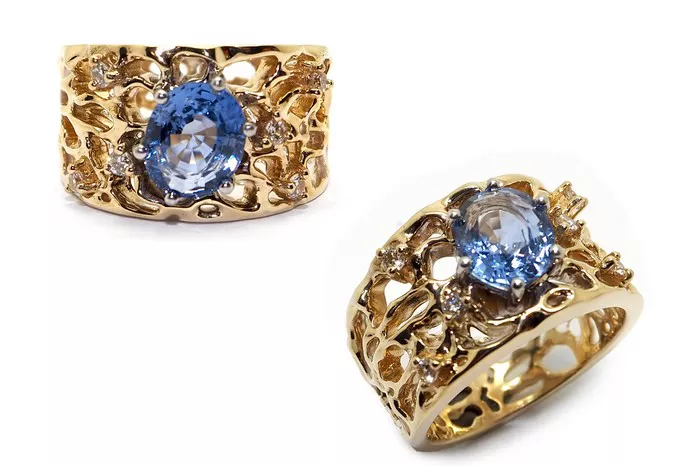Yellow sapphire, a variety of sapphire that owes its yellow hue to trace amounts of iron (Fe) within its crystalline structure, is a gemstone of great significance in the jewelry world. With a hardness of 9 on the Mohs scale, a specific gravity ranging from 3.80 to 4.05, and a refractive index between 1.76 and 1.78 with a birefringence of 0.008 to 0.009, yellow sapphire exhibits a distinct rigid corundum luster and can display excellent fire when well-cut. Its relatively common occurrence and larger gemstone sizes make it a popular choice for jewelry making. Below is a detailed guide on how to identify genuine yellow sapphire from a professional perspective.
Understanding Yellow Sapphire
Yellow sapphire belongs to the corundum family, which also includes ruby. Its color can range from light yellow to vivid yellow, and it is primarily found in sapphire mines across the globe, with Sri Lanka being a notable producer. Yellow sapphires from Sri Lanka often exhibit a fluorescent glow ranging from apricot to orange under long-wave ultraviolet light.
In commercial transactions, grading the color of yellow sapphires is simpler compared to yellow diamonds, generally falling into two categories: “Yellow” and “Vivid Yellow.” The color intensity and purity significantly affect the value of yellow sapphires.
Professional Identification Techniques
Identifying genuine yellow sapphire involves a combination of visual inspection, gemological testing, and understanding the properties and characteristics unique to natural and treated sapphires.
1. Visual Inspection
- Natural Color Distribution: Natural yellow sapphires often display color zoning or uneven color distribution, which is a natural occurrence in gemstones formed under geological conditions.
- Saturation and Hue: Vivid, evenly saturated yellow hues are more valuable. Check for any secondary colors like green or brown that might detract from the primary yellow hue.
- Inclusions: Natural sapphires often contain inclusions such as rutile silk, fingerprints, or liquid inclusions. These are natural birthmarks that help authenticate the gemstone.
- Transparency: While some yellow sapphires can be transparent, others may exhibit translucency or opacity, depending on their composition and treatment history.
- Brilliance and Fire: Well-cut yellow sapphires will exhibit excellent brilliance and fire, with light reflecting and refracting in a pleasing manner.
- Symmetry and Polish: Examine the gemstone for any irregularities in cutting or polishing, which can be indicative of poor craftsmanship or synthetic origins.
2. Gemological Testing
- UV-Visible Spectroscopy: This test helps identify the absorption patterns specific to natural yellow sapphires. Synthetic sapphires may show different absorption lines.
- Luminescence Testing: Under UV light, natural yellow sapphires from certain locations may exhibit characteristic fluorescence, which can help in identification.
- Refractive Index Measurement: The refractive index of yellow sapphire ranges between 1.76 and 1.78. Measuring the refractive index helps distinguish it from other gemstones with similar appearances.
- Specific Gravity Testing: Yellow sapphires have a specific gravity of 3.80 to 4.05. This can be measured using a hydrostatic balance or a specific gravity liquid.
- Thermal Conductivity Testing: Sapphires are good conductors of heat. A thermal conductivity probe can help distinguish them from other gemstones like glass or synthetic spinel, which conduct heat differently.
- Mohs Scale Scratch Test: Although not commonly used in gemological laboratories due to the risk of damaging the gemstone, sapphires’ hardness can be confirmed by their resistance to scratching.
3. Detection of Treatments
- Common Practice: Heat treatment is a common enhancement practice for sapphires to improve color or clarity. Treated sapphires should be disclosed as such.
- Identification: Heat-treated sapphires may show telltale signs such as color zoning patterns that are too uniform or the absence of certain inclusions that would naturally occur.
- Surface Diffusion: This treatment involves diffusing beryllium into the surface of the sapphire to enhance color. It can be detected through spectroscopy and examination under high magnification.
- Identification: Diffusion-treated sapphires may show color concentration near the surface, with fading color towards the center.
- Fracture Filling: Fractures in sapphires can be filled with materials like glass or resin to improve clarity.
- Identification: Filling can be detected under high magnification or with the use of advanced gemological instruments like a microscope with UV lighting or a fiber-optic probe.
- Rare Practice: Irradiation is less common but can change the color of sapphires.
- Identification: Irradiation-treated sapphires may show unusual color patterns or residual radioactivity, which can be detected with specialized equipment.
4. Distinguishing Synthetic Sapphires
- Flux Growth: Synthetic sapphires can be produced using methods like the Verneuil process or flux growth.
- Identification: Synthetic sapphires may exhibit perfect clarity, lack natural inclusions, and show growth patterns different from natural ones.
- Absorption Spectra: Synthetic sapphires often have absorption spectra that differ from natural ones, particularly in the UV-Visible range.
- Thermal Conductivity: While synthetic sapphires are also good conductors of heat, their exact thermal conductivity values might slightly differ from natural ones.
- Optical Properties: Synthetic sapphires may show perfect optical symmetry and a lack of natural internal stress patterns.
Conclusion
In summary, identifying genuine yellow sapphire involves a thorough understanding of its natural characteristics, gemological testing, and being aware of common treatments and synthetic production methods. By combining visual inspection, gemological analysis, and expert advice, you can ensure that the yellow sapphire you are acquiring is genuine and of high quality.
Related topic:
- Yellow Sapphire vs Yellow Diamond: How to Accurately Identify?
- Yellow Sapphire vs White Sapphire: What is the Difference?
- Yellow Sapphire vs Topaz: Similar Colors, How to Distinguish?


